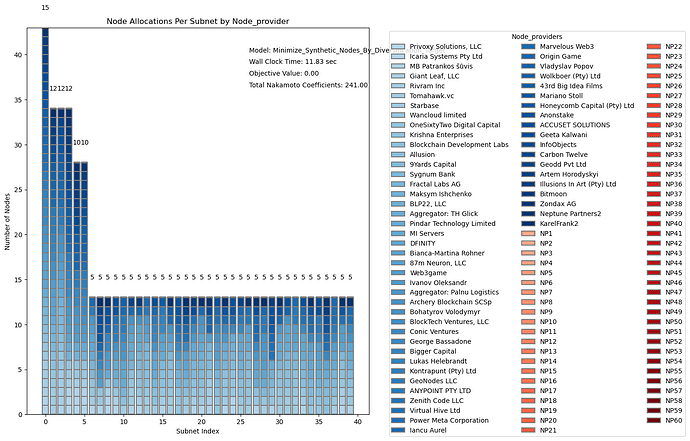@Lorimer @wpb, to clarify, the target topology is as @wpb indicates the topology that should be worked towards, in that it is the topology intended to be achieved in the next half to one year. This was also stated when the first proposal was submitted for voting.
The target topology has been used as basis for the optimization tool that was used to determine how many Gen2 node machines were required, taking into account the decentralization coefficients. You can find further discussion on these topic here. The optimization tooling is open source and the community has also contributed to that. Note that the optimization tooling is a python module, and is different from the dre “health” tooling that is weekly run for node replacements; but both calculate the same Nakamoto coefficients.
When mentioning that the limiting factor for decentralization is the country coefficient and the number of Gen2 spare nodes, and that spare nodes are not included in the optimization tooling, this does not mean - as @lorimer assumed - that there are not enough Gen2 nodes, so the conclusion that community was asleep or that target topology is unachievable is not correct:
- There are approximately (not taking into account dead nodes or nodes in maintance) 361 Gen2 Nodes, whereas the target topology requires a minimum of 136 Gen2 nodes (based on the number of nodes in SEV subnets). The difference between these two numbers can be explained by (1). the target decentralization coefficients required more nodes in new countries, with new node providers, and in new data centers, also for the subnets that are not SEV subnets (2). several new node providers had ordered node machines before the optimization tooling was introduced and voted upon, so these already ordered nodes (the so called “node pipeline”) were agreed by the community to be added to the IC network as well.
- If you run the optimization tool while removing 20 Gen2 nodes, the target topology can still be achieved, even with Fiduciary subnet size and II subnet size increased to 34. See also the outcome below. Feel free to run this yourself.
- The tooling is using linear optimization, and you can actually see the outcome per node per subnet per node provider, as proof that this optimization can be achieved.
Since the optimization tooling is stand alone and not integrated in the NNS, as @wpb rightly states executing all subnet proposals to achieve this topology in practice is quite complex and time consuming, and any suggestions are welcome in that respect. The intention is to incrementally achieve this through the individual subnet proposals that the DRE is submitting every week. But other ideas are very much welcome.
In conclusion, @sat @lorimer @wpb as the new target topology can be achieved with the available nodes, I do not see a reason for rejecting the motion proposal.
